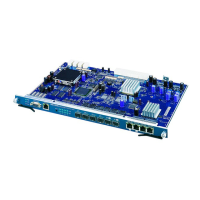Chapter 8 Multicast Screens
Management Switch Card User’s Guide
187
8.1.5 IGMP Fast Leave
When a host leaves a multicast group (224.1.1.1), it sends an IGMP leave message to inform all
routers (224.0.0.2) in the multicast group. When a router receives the leave message, it sends a
specific query message to all multicast group (224.1.1.1) members to check if any other hosts are
still in the group. Then the router deletes the host’s information.
With the IGMP fast leave feature enabled, the router (DSLAM) removes the host’s information from
the group member list once it receives a leave message from a host and the fast leave timer
expires.
8.1.6 Multicast Listener Discovery
The Multicast Listener Discovery (MLD) protocol (defined in RFC 2710) is derived from IPv4's
Internet Group Management Protocol version 2 (IGMPv2). MLD uses ICMPv6 message types, rather
than IGMP message types. MLDv1 is equivalent to IGMPv2 and MLDv2 is equivalent to IGMPv3.
• MLD allows an IPv6 switch or router to discover the presence of MLD hosts who wish to receive
multicast packets and the IP addresses of multicast groups the hosts want to join on its network.
• MLD snooping and MLD proxy are analogous to IGMP snooping and IGMP proxy in IPv4.
• MLD filtering controls which multicast groups a port can join.
• An MLD Report message is equivalent to an IGMP Report message, and a MLD Done message is
equivalent to an IGMP Leave message.
8.2 IGMP Setup Screen
Click Multicast > IGMP in the navigation panel to display the screen shown next. Use this screen
to configure your IGMP settings.

